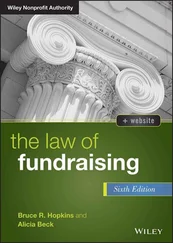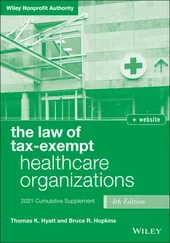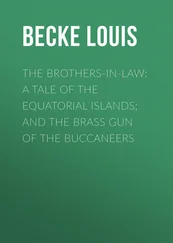Bruce R. Hopkins - The Tax Law of Charitable Giving
Здесь есть возможность читать онлайн «Bruce R. Hopkins - The Tax Law of Charitable Giving» — ознакомительный отрывок электронной книги совершенно бесплатно, а после прочтения отрывка купить полную версию. В некоторых случаях можно слушать аудио, скачать через торрент в формате fb2 и присутствует краткое содержание. Жанр: unrecognised, на английском языке. Описание произведения, (предисловие) а так же отзывы посетителей доступны на портале библиотеки ЛибКат.
- Название:The Tax Law of Charitable Giving
- Автор:
- Жанр:
- Год:неизвестен
- ISBN:нет данных
- Рейтинг книги:5 / 5. Голосов: 1
-
Избранное:Добавить в избранное
- Отзывы:
-
Ваша оценка:
- 100
- 1
- 2
- 3
- 4
- 5
The Tax Law of Charitable Giving: краткое содержание, описание и аннотация
Предлагаем к чтению аннотацию, описание, краткое содержание или предисловие (зависит от того, что написал сам автор книги «The Tax Law of Charitable Giving»). Если вы не нашли необходимую информацию о книге — напишите в комментариях, мы постараемся отыскать её.
The Tax Law of Charitable Giving — читать онлайн ознакомительный отрывок
Ниже представлен текст книги, разбитый по страницам. Система сохранения места последней прочитанной страницы, позволяет с удобством читать онлайн бесплатно книгу «The Tax Law of Charitable Giving», без необходимости каждый раз заново искать на чём Вы остановились. Поставьте закладку, и сможете в любой момент перейти на страницу, на которой закончили чтение.
Интервал:
Закладка:
With a progressive tax system, it is inevitable that the tax benefits of a deduction are likely to accrue to the wealthier of taxpayers. Thus, one commentator lamented the “disparate treatment between taxpayers who itemize their tax returns [sic] and those who claim the standard deduction.” 162 Another observer stated that the charitable deduction “has almost always disproportionately benefited a relatively high-income minority of households.” 163 Those finding this to be a great inequity often fail to understand that a form of charitable deduction is built into the standard deduction. In any event, an above-the-line charitable deduction is an expensive undertaking for the federal government. It is not likely to be tried again soon.
From time to time, as noted, a tax credit is considered as an alternative or a supplement to the charitable contribution deduction for individuals. Tax credits of this nature, also as noted, can be costly from the standpoint of the federal fisc. Further, studies have shown that a federal charitable tax credit would significantly alter the allocation of gift dollars to types of charities in relation to the way these dollars are directed to charity under the current federal income tax charitable contribution deduction system.
NOTES
1 1See Part Two.
2 2See Part Three.
3 3See Part Five.
4 4See, e.g., ch. 23.
5 5Companion books by the author provide a summary of the law concerning tax-exempt organizations as such (Tax-Exempt Organizations), planning considerations for tax-exempt organizations (Planning Guide), IRS examinations of tax-exempt organizations (IRS Audits), and regulation of the charitable fundraising process (Fundraising). Governance of tax-exempt organizations is the subject of Hopkins & Gross, Nonprofit Governance: Law, Practices, & Trends (Hoboken, NJ: John Wiley & Sons, 2009). These bodies of law are reviewed in less technical detail in Hopkins, Starting and Managing a Nonprofit Organization: A Legal Guide, 7th edition (Hoboken, NJ: John Wiley & Sons, 2017). All of these areas of the law (and others) are also covered in the Bruce R. Hopkins' Nonprofit Law Library, an e-book published by John Wiley & Sons in 2013.
6 6The term nonprofit organization is used throughout, rather than the term not-for-profit. The latter term is used, however, in the federal tax setting, to describe activities (rather than organizations) whose expenses do not qualify for the business expense deduction. Internal Revenue Code of 1986, as amended, section (IRC §) 183. Throughout this book, the Internal Revenue Code is cited as the “IRC.” The IRC constitutes Title 26 of the United States Code.
7 7A discussion of these sectors appears in Ferris & Graddy, “Fading Distinctions among the Nonprofit, Government, and For-Profit Sectors,” in Hodgkinson, Lyman, & Associates, The Future of the Nonprofit Sector, ch. 8(San Francisco: Jossey-Bass, 1989). An argument that the sector should be called the first sector is advanced in Young, “Beyond Tax Exemption: A Focus on Organizational Performance versus Legal Status,” in id. ch. 11.
8 8See Tax-Exempt Organizations ch. 12.
9 9The Supreme Court wrote that a “nonprofit entity is ordinarily understood to differ from a for-profit corporation principally because it ‘is barred from distributing its net earnings, if any, to individuals who exercise control over it, such as members, officers, directors, or trustees’” (Camps Newfound/Owatonna, Inc. v. Town of Harrison, 520 U.S. 564, 585 (1997), quoting from Hansmann, “The Role of Nonprofit Enterprise,” 89 Yale L.J. 835, 838 (1980)).
10 10One commentator stated that charitable and other nonprofit organizations “are not restricted in the amount of profit they may make; restrictions apply only to what they may do with the profits.” Weisbrod, “The Complexities of Income Generation for Nonprofits,” in Hodgkinson et al., ch. 7.
11 11Norwitz, “The Metaphysics of Time: A Radical Corporate Vision,” 46 Bus. Law. (no. 2) 377 (Feb. 1991).
12 12The federal law of tax exemption for charitable organizations requires that each of these entities be organized and operated so that “no part of . . . [its] net earnings . . . inures to the benefit of any private shareholder or individual.” IRC § 501(c)(3).
13 13IRC §§ 501(c)(9), (17), and (21) (employee benefit trusts), and IRC § 501(c)(7) (social clubs). See Tax-Exempt Organizations chs. 18, 15, respectively.
14 14This broad definition carries with it the connotation of philanthropy. E.g., Van Til, “Defining Philanthropy,” in Van Til & Associates, Critical Issues in American Philanthropy, ch. 2(San Francisco: Jossey-Bass, 1990). Also Payton, Philanthropy: Voluntary Action for the Public Good (New York: Macmillan, 1988); O'Connell, Philanthropy in Action (New York: The Foundation Center, 1987).
15 15The complexity of the federal tax law is such that the charitable sector (using the term in its broadest sense) is also divided into two segments: charitable organizations that are considered private (private foundations) and charitable organizations that are considered public (all charitable organizations other than those that are considered private); these nonprivate charities are frequently referred to as public charities. See Tax-Exempt Organizations ch. 12.
16 16McGovern, “The Exemption Provisions of Subchapter F,” 29 Tax Law. 523 (1976). Other overviews of the various tax exemption provisions are in Hansmann, “The Rationale for Exempting Nonprofit Organizations from Corporate Income Taxation,” 91 Yale L.J. 69 (1981); Bittker & Rahdert, “The Exemption of Nonprofit Organizations from Federal Income Taxation,” 85 Yale L.J. 299 (1976).
17 17H. Rep. No. 72, 78th Cong., 1st Sess. 17 (1928).
18 18Lapin, “The Golden Hills and Meadows of the Tax-Exempt Cemetery,” 44 Taxes 744 (1966).
19 19“Comment,” 27 Iowa L. Rev. 128, 151–155 (1941).
20 20H. Rep. No. 704, 73d Cong., 2d Sess. 21–25 (1934).
21 21These are the charitable, educational, religious, scientific, and like organizations referenced in IRC § 501(c)(3).
22 22See Tax-Exempt Organizations § 1.3.
23 23In 1894, Congress imposed a tax on corporate income. This was the first time Congress was required to define the appropriate subjects of tax exemption (inasmuch as prior tax schemes specified the entities subject to taxation). The Tariff Act of 1894 provided exemption for nonprofit charitable, religious, and educational organizations; fraternal beneficiary societies; certain mutual savings banks; and certain mutual insurance companies. The 1894 legislation succumbed to a constitutional law challenge (Pollock v. Farmers' Loan & Trust Co., 157 U.S. 429 (1895), overruled on other grounds sub nom. South Carolina v. Baker, 485 U.S. 505 (1988)). The Sixteenth Amendment was subsequently ratified, and the Revenue Act of 1913 was enacted. In general, Pollack, “Origins of the Modern Income Tax, 1894–1913,” 66 Tax Law. (no. 2) (Winter 2013).
24 24McGovern, “The Exemption Provisions of Subchapter F,” 29 Tax Law. 523, 524 (1976).
25 25Income Tax Regulations (Reg.) § 1.501(c)(3)-1(d)(2).
26 26Statute of Charitable Uses, 43 Eliz., c.4.
27 27Cobb, The Rise of Religious Liberty in America, 482–528 (1902).
28 28Torpey, Judicial Doctrines of Religious Rights in America, 171 (1948).
29 29Trinidad v. Sagrada Orden de Predicadores de la Provincia del Santisimo Rosario de Filipinas, 263 U.S. 578, 581 (1924).
30 30Walz v. Tax Commission, 397 U.S. 664, 673 (1970).
31 31Portland Golf Club v. Commissioner, 497 U.S. 154, 161 (1990).
32 32Duffy v. Birmingham, 190 F.2d 738, 740 (8th Cir. 1951).
33 33Id.
34 34St. Louis Union Trust Co. v. United States, 374 F.2d 427, 432 (8th Cir. 1967).
Читать дальшеИнтервал:
Закладка:
Похожие книги на «The Tax Law of Charitable Giving»
Представляем Вашему вниманию похожие книги на «The Tax Law of Charitable Giving» списком для выбора. Мы отобрали схожую по названию и смыслу литературу в надежде предоставить читателям больше вариантов отыскать новые, интересные, ещё непрочитанные произведения.
Обсуждение, отзывы о книге «The Tax Law of Charitable Giving» и просто собственные мнения читателей. Оставьте ваши комментарии, напишите, что Вы думаете о произведении, его смысле или главных героях. Укажите что конкретно понравилось, а что нет, и почему Вы так считаете.












